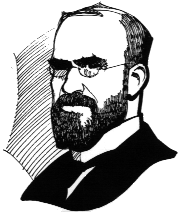
THE DEWEY DECIMAL SYSTEM
The Dewey Decimal Classification System (DDC) is the most widely used library classification system
in the world. It is used in more than 135 countries. It was invented by a man named Melville Louis Kossuth Dewey when he was 21 years old, working as a student assistant in a college library.
Dewey is credited with beginning the field of library science in the United States.
Dewey was born on December 10, 1851.
His family was poor, and lived in a small town in upper New York State.
Later he cut his first name to Melvil, dropped his middle names
and, for a short time, even spelled his last name as Dui.
Dewey's system of cataloguing books is used today in most local and school libraries.
It organizes all the nonfiction works by grouping books together that are on the same subject.
That makes them much easier to find.
It uses a combination of letters and numbers starting with 000 and going to 999.
Believe it or not!!!
Not all Dewey classified books are nonfiction. Do you know any that are fiction? Click here.
Take a multimedia tour of Dewey's system here.
Here are the Dewey Decimal System's ten main groups.
Look at the table below to see how some of them are divided up even more.
|
100 Philosophy and Psychology |
200 Religion | 300 Social Science |
400 Language | 500 Science and Math |
600 Technology (Applied Sciences) | 700 Arts and Recreation |
800 Literature | 900 Geography and History |
| 000 010 020 030 040 050 060 070 080 090 100 110 120 130 140 150 160 170 180 190 200 210 220 230 240 250 260 270 280 290 300 310 320 330 340 350 360 370 380 390 400 410 420 430 440 450 460 470 480 490 |
Computers, Information, and General Reference Bibliographies Library & information science Encyclopedias & books of facts [Unassigned] Magazines, journals & serials Associations, organizations & museums Journalism, publishing & news media Quotations Manuscripts & rare books Philosophy Metaphysics Epistemology Astrology, parapsychology & the occult Philosophical schools of thought Psychology Logic Ethics Ancient, medieval & Eastern philosophy Modern western philosophy Religion Philosophy & theory of religion The Bible Christianity & Christian theology Christian practice & observance Christian pastoral practice & religious orders Church organization, social work & worship History of Christianity Christian denominations Other religions Social sciences Statistics Political science Economics Law Public administration & military science Social problems & social services Education Commerce, communications & transportation Customs, etiquette & folklore Language Linguistics English & Old English Languages German & related languages French & related languages Italian, Romanian & related languages Spanish & Portuguese languages Latin & Italic languages Classical & modern Greek languages Other languages |
500 510 520 530 540 550 560 570 580 590 600 610 620 630 640 650 660 670 680 690 700 710 720 730 740 750 760 770 780 790 800 810 820 830 840 850 860 870 880 890 900 910 920 930 940 950 960 970 980 990 |
Science and Math Mathematics Astronomy Physics Chemistry Earth sciences & geology Fossils & prehistoric life Biology & life sciences Plants (Botany) Animals (Zoology) Technology (Applied Sciences) Medicine Engineering Agriculture Home & family management Management & public relations Chemical engineering Manufacturing Manufacturing specific products Building & construction Arts and Recreation Landscaping & area planning Architecture Sculpture, ceramics & metalwork Drawing & decorative arts Painting Graphic arts Photography Music Sports, games & entertainment Literature American literature in English English & Old English literatures German & related literatures French & related literatures Italian, Romanian & related literatures Spanish & Portuguese literatures Latin & Italic literatures Classical & modern Greek literatures Other literatures Geography and History Geography & travel Biography & genealogy History of the ancient world (to ca. 499 A.D.) History of Europe (ca. 500 A.D.- ) History of Asia History of Africa History of North America History of South America History of other regions |
ACTIVITY:
Drag the red book title into its proper column. (Need more help? Click here for more details.)
|
000 |
100 Philosophy and Psychology |
200 Religion |
300 Social Science |
400 Language |
500 Natural Science and Mathematics |
600 Technology (Applied Sciences) |
700 Arts |
800 Literature |
900 Geography and History |
| All About Rocks | Volcanoes | Music of the 20th Century | Earthworms | The Hindu Religion | Chinese Cooking | Paul Bunyan | Stars of the Northern Hemisphere | The Geography of the Middle East | Ancient Rome |
| Bridge Building Made Easy | Bulldogs | World War I | The Periodic Table of the Elements | How to Be a Better Photographer | The Big Book of Fairy Tales | Poetry for Children | Indians of N. America |
From Tadpole to Frog | Sculpture for Beginners |
| French Poetry | How to Build with Wood | The Color Wheel | All About Mushrooms | Easy Lessons in Algebra | Dinosaur Fossils | The History of the Catholic Church | How Magnets Work | Sances: Are They for Real? | Lessons in English Grammar |
Want to learn more? Of course you do!!!
Fiction and nonfiction
Call numbers
Left-to-Right and Top-to-Bottom
How fiction and nonfiction are shelved
What does a fiction call number look like?
What does a nonfiction call number look like?
ACTIVITY: Test your knowledge of the Dewey Decimal System here.